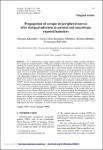Propagation of scrapie in peripheral nerves after footpad infection in normal and neurotoxin exposed hamsters
Kratzel, Christine
Mai, Jessica
Madela, Kazimierz
Beekes, Michael
Krüger, Dominique
As is known from various animal models, the spread of agents causing transmissible spongiform encephalopathies (TSE) after peripheral infection affects peripheral nerves before reaching the central nervous system (CNS) and leading to a fatal end of the disease. The lack of therapeutic approaches for TSE is partially due to the limited amount of information available on the involvement of host biological compartments and processes in the propagation of the infectious agent. The in vivo model presented here can provide information on the spread of the scrapie agent via the peripheral nerves of hamsters under normal and altered axonal conditions. Syrian hamsters were unilaterally footpad (f.p.) infected with scrapie. The results of the spatiotemporal ultrasensitive immunoblot-detection of scrapie-associated prion protein (PrP(Sc)) in serial nerve segments of both distal sciatic nerves could be interpreted as a centripetal and subsequent centrifugal neural spread of PrP(Sc) for this route of infection. In order to determine whether this propagation is dependent on main components in the axonal cytoskeleton (e.g. neurofilaments, also relevant for the component ;a' of slow axonal transport mechanisms), hamsters were treated -in an additional experiment- with the neurotoxin beta,beta-iminodiproprionitrile (IDPN) around the beginning of the scrapie infection. A comparison of the Western blot signals of PrP(Sc) in the ipsilateral and in the subsequently affected contralateral sciatic nerve segments with the results revealed from IDPN-untreated animals at preclinical and clinical stages of the TSE disease, indicated similar amounts of PrP(Sc). Furthermore, the mean survival time was unchanged in both groups. This in vivo model, therefore, suggests that the propagation of PrP(Sc) along peripheral nerves is not dependent on an intact neurofilament component of the axonal cytoskeleton. Additionally, the model indicates that the spread of PrP(Sc) is not mediated by the slow component ;a' of the axonal transport mechanism.
No license information

